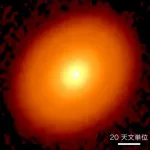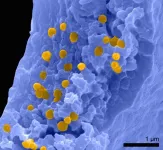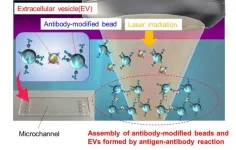(Press-News.org) The central question in the ongoing hunt for dark matter is: what is it made of? One possible answer is that dark matter consists of particles known as axions. A team of astrophysicists, led by researchers from the universities of Amsterdam and Princeton, has now shown that if dark matter consists of axions, it may reveal itself in the form of a subtle additional glow coming from pulsating stars.
Dark matter may be the most sought-for constituent of our universe. Surprisingly, this mysterious form of matter, that physicist and astronomers so far have not been able to detect, is assumed to make up an enormous part of what is out there. No less than 85% of matter in the universe is suspected to be ‘dark’, presently only noticeable through the gravitational pull it exerts on other astronomical objects. Understandably, scientists want more. They want to really see dark matter – or at the very least, detect its presence directly, not just infer it from gravitational effects. And, of course: they want to know what it is.
Cleaning up two problems
One thing is clear: dark matter cannot be the same type of matter that you and I are made of. If that were to be the case, dark matter would simply behave like ordinary matter – it would form objects like stars, light up, and no longer be ‘dark’. Scientists are therefore looking for something new – a type of particle that nobody has detected yet, and that probably only interacts very weakly with the types of particles that we know, explaining why this constituent of our world so far has remained elusive.
There are plenty of clues for where to look. One popular assumption is that dark matter could be made of axions. This hypothetical type of particle was first introduced in the 1970s to resolve a problem that had nothing to do with dark matter. The separation of positive and negative charges inside the neutron, one of the building blocks of ordinary atoms, turned out to be unexpectedly small. Scientists of course wanted to know why. It turned out that the presence of a hitherto undetected type of particle, interacting very weakly with the neutron’s constituents, could cause exactly such an effect. The later Nobel Prize winner Frank Wilczek came up with a name for the new particle: axion – not just similar to other particle names like proton, neutron, electron and photon, but also inspired by a laundry detergent of the same name. The axion was there to clean up a problem.
In fact, despite never being detected, it might clean up two. Several theories for elementary particles, including string theory, one of the leading candidate theories to unify all forces in nature, appeared to predict that axion-like particles could exist. If axions were indeed out there, could they also constitute part or even all of the missing dark matter? Perhaps, but an additional question that haunted all dark matter research was just as valid for axions: if so, then how can we see them? How does one make something ‘dark’ visible?
Shining a light on dark matter
Fortunately, it seems that for axions there may be a way out of this conundrum. If the theories that predict axions are correct, they are not only expected to be mass-produced in the universe, but some axions could also be converted into light in the presence of strong electromagnetic fields. Once there is light, we can see. Could this be the key to detect axions – and therefore to detect dark matter?
To answer that question, scientists first had to ask themselves where in the universe the strongest known electric and magnetic fields occur. The answer is: in regions surrounding rotating neutron stars also known as pulsars. These pulsars – short for ‘pulsating stars’ – are dense objects, with a mass roughly the same as that of our Sun, but a radius that is around 100,000 times smaller, only about 10 km. Being so small, pulsars spin with enormous frequencies, emitting bright narrow beams of radio emission along their axis of rotation. Similar to a lighthouse, the pulsar’s beams can sweep across the Earth, making the pulsating star easily observable.
However, the pulsar’s enormous spin does more. It turns the neutron star into an extremely strong electromagnet. That, in turn, could mean that pulsars are very efficient axion factories. Every single second an average pulsar would be capable of producing a 50-digit number of axions. Because of the strong electromagnetic field around the pulsar, a fraction of these axions could convert into observable light. That is: if axions exist at all – but the mechanism can now be used to answer just that question. Just look at pulsars, see if they emit extra light, and if they do, determine whether this extra light could be coming from axions.
Simulating a subtle glow
As always in science, actually performing such an observation is of course not that simple. The light emitted by axions – detectable in the form of radio waves – would only be a small fraction of the total light that these bright cosmic lighthouses send our way. One needs to know very precisely what a pulsar without axions would look like, and what a pulsar with axions would look like, to be able to see the difference – let alone to quantify that difference and turn it into a measurement of an amount of dark matter.
This is exactly what a team of physicists and astronomers have now done. In a collaborative effort between the Netherlands, Portugal and the USA, the team has constructed a comprehensive theoretical framework which allows for the detailed understanding of how axions are produced, how axions escape the gravitational pull of the neutron star, and how, during their escape, they convert into low energy radio radiation.
The theoretical results were then put on a computer to model the production of axions around pulsars, using state-of-the-art numerical plasma simulations that were originally developed to understand the physics behind how pulsars emit radio waves. Once virtually produced, the propagation of the axions through the electromagnetic fields of the neutron star was simulated. This allowed the researchers to quantitatively understand the subsequent production of radio waves and model how this process would provide an additional radio signal on top of the intrinsic emission generated from the pulsar itself.
Putting axion models to a test
The results from theory and simulation were then put to a first observational test. Using observations from 27 nearby pulsars, the researchers compared the observed radio waves to the models, to see if any measured excess could provide evidence for the existence of axions. Unfortunately, the answer was ‘no’ – or perhaps more optimistically: ‘not yet’. Axions do not immediately jump out to us, but perhaps that was not to be expected. If dark matter were to give up its secrets that easily, it would already have been observed a long time ago.
The hope for a smoking-gun detection of axions, therefore, is now on future observations. Meanwhile, the current non-observation of radio signals from axions is an interesting result in itself. The first comparison between simulations and actual pulsars has placed the strongest limits to date on the interaction that axions can have with light.
Of course, the ultimate goal is to do more than just set limits – it is to either show that axions are out there, or to make sure that it is extremely unlikely that axions are a constituent of dark matter at all. The new results are just a first step in that direction; they are only the beginning of what could become an entirely new and highly cross-disciplinary field that has the potential to dramatically advance the search for axions.
END
Pulsars may make dark matter glow
2023-10-06
ELSE PRESS RELEASES FROM THIS DATE:
Researchers create a neural network for genomics—one that explains how it achieves accurate predictions
2023-10-06
A team of New York University computer scientists has created a neural network that can explain how it reaches its predictions. The work reveals what accounts for the functionality of neural networks—the engines that drive artificial intelligence and machine learning—thereby illuminating a process that has largely been concealed from users.
The breakthrough centers on a specific usage of neural networks that has become popular in recent years—tackling challenging biological questions. Among these are examinations of the intricacies of ...
Astronomers discover first step toward planet formation
2023-10-06
Astronomers have gotten very good at spotting the signs of planet formation around stars. But for a complete understanding of planet formation, we also need to study examples where planet formation has not yet started. Looking for something and not finding it can be even more difficult than finding it sometimes, but new detailed observations of the young star DG Taurus show that it has a smooth protoplanetary disk without signs of planet formation. This successful non-detection of planet formation may indicate ...
Faster growth of the placenta is linked to increased risk of preeclampsia
2023-10-06
Research sheds light on how genetics influences the growth of the placenta and reveals a link to increased risk of disease in the mother.
The placenta is an organ which grows in the womb alongside the foetus, which is attached to it by the umbilical cord. It is the only organ that contain tissue from both mother and child. The placenta provides oxygen and nutrients to the growing foetus and removes waste as the baby develops. A poorly functioning placenta is associated with pregnancy complications, and later risk of disease in the child.
Despite its key role, little is yet known ...
Integrated chronic care in Africa can improve outcomes and save money
2023-10-06
Across Africa about two million premature deaths each year are caused by the effects of diabetes and hypertension.
In contrast, most people living with HIV are in regular care and virally suppressed, and HIV mortality rates have fallen five-fold since their peak of 2 million deaths annually in the early 2000s to less than 500,000 in 2022.
Dr Josephine Birungi, a co-author and Graduate Researcher-Public Health at La Trobe University, said that the similarities in chronic disease management of HIV and other chronic conditions should make integrated clinics beneficial.
“The only difference is the medicine they take. We’re seeing ...
ObesityWeek® features hundreds of innovative scientific abstracts
2023-10-06
ROCKVILLE, Md.— Neary 240 scientific abstracts covering a variety of topics such as anti-obesity medications, body mass index and pediatric obesity will be featured at the 41st Annual Meeting of The Obesity Society’s (TOS) at ObesityWeek® 2023. This in-person event will take place Oct. 14–17, 2023 at the Kay Bailey Hutchison Convention Center in Dallas, Texas.
Innovative scientific research results will be presented in both oral and poster formats. These communications provide notable exposure and recognition for studies and authors, and represent cutting-edge research in obesity prevention and ...
Colombian National Cancer Institute signs MOU with BGI Genomics to combat cancer
2023-10-06
On October 2, 2023, BGI Genomics signed a Memorandum of Understanding (MoU) with the Colombian National Cancer Institute (INC or Instituto Nacional de Cancerologia). This collaboration, which aims to foster research and further develop cutting-edge solutions based on genetic sequencing for early diagnosis of cervical and colorectal cancer, reflects a shared dedication to enhancing health outcomes in the region.
The MoU was formally inked at INC facilities by Dr. Carolina Wiesner, INC Director, and Mr. Rainer Perez, alternate legal representative of BGI Genomics in Colombia. Mr. Marco Antonio Rincón, Latin America Business Director, BGI Genomics, notes: ...
Ginger pigment molecules found in fossil frogs
2023-10-06
UCC palaeontologists discover molecular evidence of phaeomelanin, the pigment that produces ginger colouration.
“This will paint a more accurate picture of ancient animal colour.”
Phaeomelanin is now toxic to animals – discovery may be first step in understand its evolution.
Palaeontologists at University College Cork (UCC) have found the first molecular evidence of phaeomelanin, the pigment that produces ginger colouration, in the fossil record.
The new study reports ...
Scientists discover ‘long colds’ may exist, as well as long Covid
2023-10-06
A new study from Queen Mary University of London, published in The Lancet’s EClinicalMedicine, has found that people may experience long-term symptoms —or ‘long colds’—after acute respiratory infections that test negative for COVID-19.
Some of the most common symptoms of the ‘long cold’ included coughing, stomach pain, and diarrhea more than 4 weeks after the initial infection. While the severity of an illness appears to be a key driver of risk of long-term symptoms, ...
Our sense of smell changes the colors we see, show scientists
2023-10-06
Our five senses bombard us with environmental input 24/7. One way our brain makes sense of this abundance of information is by combining information from two or more senses, such as between smells and the smoothness of textures, pitch, color, and musical dimensions. This sensory integration also causes us to associate higher temperatures with warmer colors, lower sound pitches with less elevated positions, and colors with the flavor of particular foods – for example, the taste of oranges with the color of the same name.
Now, a study in Frontiers in Psychology has shown experimentally that such unconscious 'crossmodal' ...
Super-efficient laser light-induced detection of cancer cell-derived nanoparticles
2023-10-06
Osaka, Japan - Can particles as minuscule as viruses be detected accurately within a mere 5 minutes? Osaka Metropolitan University scientists say yes, with their innovative method for ultrafast and ultrasensitive quantitative measurement of biological nanoparticles, opening doors for early diagnosis of a broad range of diseases.
Nanoscale extracellular vesicles (EVs) including exosomes, with diameters of 50–150 nm, play essential roles in intercellular communication and have garnered attention as biomarkers for various diseases and drug delivery capsules. Consequently, the rapid and sensitive detection of nanoscale EVs from trace samples is ...




